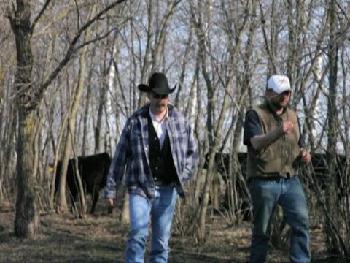After the collapse of the Soviet Union, Russians ate most of their beef cows as the system of reproduction broke down. Now American ranchers are working to rebuild Russia's herd.

Darrell Stevenson, an American cowboy and cattle rancher, is not riding the black earth country of Russia to film a western movie.
He is bringing American-bred beef cattle, American ranching technology, and American cowboy knowhow to Russia.
After the Soviet Union collapsed, beef production in Russia also collapsed. People just ate the herds as the system of sustaining cattle broke down. Today, Russia, the world's largest nation, imports most of its beef.
Right now, Russia's beef herd is less than one percent the size of the American herd, despite - as Stevenson points out - the country's abundant land and water.
"[There is a] tremendous opportunity in this country in terms of the vast resources," noted Stevenson. "[There exists a] tremendous amount of available ground, whether it is tilled or not."
Last year, Stevenson imported by ship and by air cargo jet 1,400 black Angus cows from Montana, in America's west.
A few months ago, they had their first calves, born in the black earth country of Russia.
Stevenson, along with two Russian businessmen, has set up a ranch with the goal of establishing a commercial beef herd in southern Russia.
Stevenson says Russia's long term goal is to achieve self sufficiency in meat production - pork, chicken and beef.
"We are helping establish a local beef herd, a regional beef herd, and eventually a national beef herd," added Stevenson. "With that comes the sideline of educating a labor force."
Viktor Korovkin grew up near here and saw a string of outsiders come and strip assets from the village's old collective farm. When the American-Russian joint venture started here, he was hired as a guard. Now, he is the head ranch hand.
He says the American ranching technology is more modern than the Russian technology he is familiar with.
Ekaterina Zimina grew up in St. Petersburg, Russia's second largest city. Trained as a veterinarian, she worked last year on Darrell Stevenson's Montana ranch to learn American artificial insemination and calving techniques.
She says Russians are used to working with dairy cattle confined in barns, not beef cattle on the open range.
"It is really really hard to find good enough people in Russia who can work with beef cattle," said Zimina. "Russia is world-known as dairy country. We have lots of dairy herds, dairy cows, but managing dairy and beef cows is a totally different thing."
With Russia determined to become self-sufficient in food, more and more investors are making the drive south of Moscow to see this new American-run ranch.
With plenty of cheap land and a longer growing season than much of American cattle country, Ekaterina believes many more Russians will soon be riding the range.
"We together can show these people that this is not something from the movie: cowboys really exist and it's a really hard job, and it is possible to do this even in Russia," added Zimina.
As Russia works to regain its food independence, Russians soon will be eating steaks from Black Angus raised here on the black earth country of southern Russia.
insemination: 授精
Artificial meat may answer food crisis
SK. government issues warning over US beef protests
(来源:VOA 编辑:崔旭燕)
